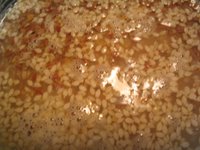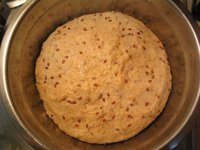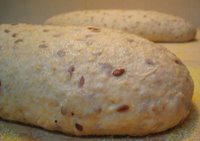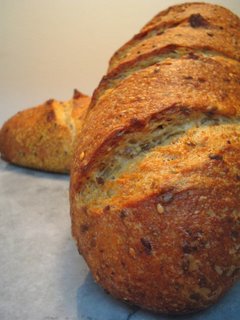
When I found out about World Bread Day, I was overjoyed! Bread holds a very special place in my heart and I have always believed that it deserves to get much more recognition than it sometimes does. My absolute favorite breads to bake are Ciabatta and Brioche, however I have already blogged these things so I felt I should participate with something new. Stangely, with my love of baking bread, G and his co-workers end up eating more than I do, and I try to bake bread at least once a week. This will be my first time participating in a blogging event and I hope my contribution is worthy.
I decided to start with a Pate Fermentee. The one I am making is from Peter Reinhart's The Bread Baker's Apprentice: Mastering the Art of Extraordinary Bread

Pate Fermentee:
1 1/8 cups unbleached all-purpose flour
1 1/8 cups unbleached bread flour
3/4 tsp salt
1/2 tsp instant yeast
3/4 cup + 2 Tbsp water, room temp
_______________________________________
-Mix flours, salt and yeast in a bowl, add the 3/4 cup water and stir until everything comes together. If you feel things are a bit too dry or stiff, add the other 2 Tbsp of water and mix in.
-Turn dough out onto a floured surface and knead for about 6 minutes or until the dough is soft and pliable and tacky.
-Transfer to a lightly oiled bowl and turn the dough to coat the top with oil. Cover and allow to ferment for 1 1/2 hours or until doubled in size (I had to let mine go for about 2 hours 15 minutes due to the fact that our little apartment is cooler than it has been).
-Turn dough out onto a lightly floured surface and gently knead to de-gas, return it to the bowl, cover it tightly and place in the refrigerator overnight or up to three days.
Now I had to figure out exactly what I wanted to make with this pre-ferment. I wanted to make something similar to a bread I used to make when I worked in a bakeshop. It was simply called "Rustic" and is a variation of Pain de Campagne, in that it has flax and sesame seeds and wheat germ added. I also have decided to put a little bit of cornmeal just to experiment.

So, along with making the pate fermentee the night before, a soaker was also necessary. What is a soaker? Basically it is the seeds and other coarse grains you are going to put into your bread soaked overnight to help soften and coax more flavor from them. This particular soaker is just from my head and contained:
Soaker:
3 Tbsp whole flax seeds
2 Tbsp sesame seeds
3 Tbsp cornmeal (coarse ground if you can find it)
1 cup water
________________
-Mix all together, cover tightly and refrigerate overnight. The seeds and cornmeal will soak up a good deal of the water.
And now, for the main event, this recipe is adapted from Peter Reinhart's The Bread Baker's Apprentice :
"Rustic" Pain de Campagne:

1 recipe pate fermentee, found above
1 3/4 cup unbleached bread flour
1/3 cup whole wheat flour
3/4 tsp salt
1 tsp instant yeast
2 Tbsp wheat germ
soaker, from above
1/2 cup lukewarm water
_____________________________________
-Remove the pate fermentee from the refrigerator, cut into about 10 pieces, cover with plastic wrap and allow to sit at room temp for an hour to remove the chill.
-Sift flours, salt and yeast together into a bowl with the pate fermentee.
-Add the soaker and the water and stir until the mixture comes together (you may need to add a little more water).
-Turn dough onto a lightly floured surface and knead for 8 to 10 minutes until the dough is soft and elastic. Lightly oil a large bowl and place dough inside, turning it to coat in oil. Cover and let bulk ferment for about 2 hours, or until it doubles in size.
-Gently remove the dough from the bowl so as to de-gas as little as possible. Divide the dough into 2 pieces and gently shape into batards.

Sprinkle cornmeal lightly onto sheetpans, or a peel and place the loaves on the sheetpans. Cover with plastic (at this point, I put the loaves in the refrigerator for another long cold fermentation..if you do this, pull the loaves out the next day and then follow the rest of the recipe) and allow to proof for about 1 hour, or until they are about 1 1/2 times their original size.
-Preheat your oven to 500f. If you are going to use steam, put your pan in the oven now, and get some water heating about half hour before you are going to bake the bread.
-When the loaves are ready, uncover and slash the loaves as you see fit. Either slide the loaves from your peel to your baking stone, or slide the sheetpans into the oven. If you are using steam, pour a cup of the hot water into your steam pan and shut the door (beware of evil steam burns!) After about 5 minutes, lower the oven heat to 450f. After 5 more minutes, if there is still any water in the steampan, remove it carefully.
 Bake for at least 20 more minutes, checking the loaves and rotating as needed. The bread should be a deep golden brown, and feel light for it's size.
Bake for at least 20 more minutes, checking the loaves and rotating as needed. The bread should be a deep golden brown, and feel light for it's size.-Allow the bread to cool, then slice and enjoy! It is great with olive oil, butter, cheese, makes for interesting crostini and bruschetta. This is just a wonderful bread.
A big thanks to Zorra at Kochtopf for hosting this event!
Happy Baking, and Happy World Bread Day!
Technorati Tags:worldbreadday'06, world bread day '06, bread, baking, pain de campagne
Generated By Technorati Tag Generator
world bread day '06





















1 comment:
It might be too late to post a comment on this... The last step before baking: "Gently remove the dough from the bowl so as to de-gas as little as possible. Divide the dough into 2 pieces and gently shape into batards." When I shape bread I usually end up flattening it out or stretching it and then shaping it. How should I go about shaping this as to de-gas it as little as possible? Instead of rolling it out then shaping it should I just squish the dough halves into longish baguette shapes? Thanks!
Post a Comment